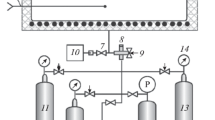Abstract
Annealing processes often use exothermic gas as a furnace atmosphere to protect against oxidation. A mathematical model of such a process was used to determine the effects of generator temperature, heat exchanger temperature, generator air-methane ratio and furnace temperature on the equilibrium composition of the furnace atmosphere. For temperatures above 700 °C, the only gas phase reaction which need be considered is the water gas shift reaction. At lower temperatures it is possible to form methane from CO and H2 and, below about 600 °C, CO can decompose resulting in loss of carbon from the atmosphere. Both methane formation and carbon loss tend to make the furnace atmosphere more oxidizing. Because of slow reaction rates, neither the formation of methane nor loss of carbon is likely to approach equilibrium, even if the water gas shift reaction reaches equilibrium. The implications of these factors for furnace atmosphere control are discussed.
Similar content being viewed by others
Author information
Authors and Affiliations
Rights and permissions
About this article
Cite this article
Stickels, C.A. Thermochemistry of exothermic gas atmospheres. J. Heat Treating 2, 20–27 (1981). https://doi.org/10.1007/BF02833070
Issue Date:
DOI: https://doi.org/10.1007/BF02833070




